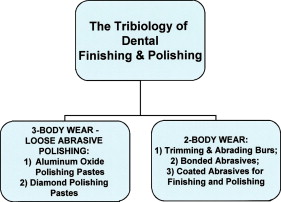Effective finishing and polishing of dental restorations not only result in optimal aesthetics but also provide for acceptable oral health of soft tissues and marginal integrity of the restorative interface. This review of abrasive technology in dentistry provides an overview of basic principles of abrasive science and considers some research concerning clinically relevant questions. The article also discusses some recent innovations in finishing and polishing devices. This review brings forward some newly published, outcome-based information concerning the relevance and importance of an effective knowledge of finishing and polishing techniques and materials. The overall aim is to provide an enhanced awareness and broader knowledge of the principles and tools available to produce optimal surface finishing and integrity in dental restoratives.
Effective finishing and polishing of dental restorations not only result in optimal aesthetics but also provide for acceptable oral health of soft tissues and marginal integrity of the restorative interface. In an earlier published review article, this author noted some of the difficulties resulting from improperly finished and polished restorations, including “excessive plaque accumulation, gingival irritation, increased surface staining, and poor or suboptimal esthetics of the restored teeth” . This review of abrasive technology in dentistry provides an overview of basic principles of abrasive science and considers some research concerning clinically relevant questions involving this subject. The article also discusses some recent innovations in finishing and polishing devices in restorative dentistry. This review brings forward some newly published, outcome-based information concerning the relevance and importance of an effective knowledge of finishing and polishing techniques and materials. The overall aim is to provide the reader with an enhanced awareness and broader knowledge of the principles and tools available to produce optimal surface finishing and integrity in dental restoratives.
Basic principles of tribiology as it relates to abrasive science in dentistry
The mechanisms involved in mechanical finishing and polishing using abrasive particles are part of tribiology, the discipline associated with material science, physics, chemistry and surface-contact engineering . A description of a tribiological system consists of a set of experimental parameters (eg, applied load, velocity, and duration of motion) and the system structure (eg, the two bodies in contact, the interfacial media, and the surrounding media).
Finishing and polishing devices, materials, and procedures are intended to produce intentional, selective, and controlled wear of dental restorative-material surfaces. Wear is defined as a cumulative surface damage phenomenon in which material is removed from a body as small debris particles, primarily by mechanical processes. The wear mechanism is the transfer of energy with removal or displacement of material. The four major wear mechanisms are adhesion, abrasion, surface fatigue, and tribochemical reactions. In polishing with abrasive particles, the wear mechanism is mostly abrasive wear, but other mechanisms are also possible. These include surface fatigue and the development of ploughing grooves or scratches, which in some instances are accompanied by hertzian fractures. For the classification of the abrasive-wear modes, this article uses the most widely accepted terms. These are two-body abrasion and three-body abrasion. These terms illustrate the experimental situations encountered in finishing and polishing techniques, as illustrated in Fig. 1 . In a two-body mode, the bound abrasive particle is solidly fixed to the substrate (see Fig. 1 ). In a three-body abrasive mode, free (or loose) particles form slurry between the specimen surface to be polished and a flat polishing substrate (see Fig. 1 ). The free particles in a three-body wear mode may be intentionally added abrasives or detached debris from the worn surface. Most dental finishing and polishing devices operate in the two-body mode. Nevertheless, dentist, hygienists, and laboratory technicians use the three-body abrasive mode in the form of loose abrasives, such as prophy or polishing pastes.





